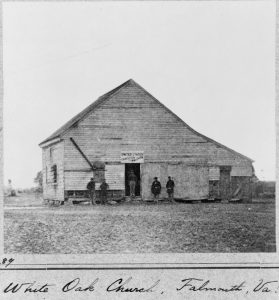About the White Oak Primitive Baptist Church
The simple house of worship on White Oak Road, across from the White Oak Civil War Museum, has its historic roots in the separation of church and state and was a hub of Union Army activity in the winter of 1862-63.
During the colonial period, the Anglican church was Virginia’s official faith, but other groups, such as Baptists, found tremendous growth opportunities in the Old Dominion. Preaching a simpler doctrine which they believe more closely aligns with the early churches of the New Testament, the Baptists’ ranks swelled as ever more immigrants arrived, pushing the physical and social boundaries of the colony.
In the Beginning: The White Oak Church of Christ
First known as White Oak Church of Christ, the church was organized in 1789 as a branch of Chopawamsic Church. In 1835, its meeting house and one acre of land were deeded to the church by John Moncure for $1.
What Does “Primitive” Mean?
During the 1830s, its name was changed to White Oak Primitive Baptist Church because of strong opposition to some other Baptists straying from original doctrines. The group that met at White Oak Road considered themselves “old school” or “primitive” for adhering to the simpler ways. Indeed, White Oak Primitive Baptist chose to take itself out of fellowship with Fredericksburg Baptist in 1835 due to “the loose and divided state of the churches.”
White Oak Primitive Baptist Church as a Center of Union Encampment
Located as it was in the heart of occupied territory, White Oak Primitive Baptist ceased to hold its own services from December 1861 to February 1868. After the arrival of the Union Army in 1862, the church was used by necessity as a hospital, a United States Christian Commission station, and a photography studio. Delegates from the U.S. Christian Commission distributed testaments to soldiers and conducted worship services and prayer meetings. Fifty-two soldiers were buried on church grounds, but it is believed their remains were later moved to the Fredericksburg National Cemetery.
New Churches Arise from the Old
White Oak Primitive Baptist Church had no bar to membership due to race, and many early African American members had been enslaved at nearby Chatham plantation. However, African American worshippers were separated from whites by a three-foot wall,* and, after the War, the separation would be of a more permanent sort. In 1868, the church resolved to dismiss “colored members who desire separate organization.” Of that group, 59 members moved to Alexandria and chose Fielding Roberson from among their number to serve as preacher. York Johnson was chosen as preacher from among 27 members who came to constitute “Bethlehem Church of colored members” in Stafford County, now known as Bethlehem Primitive Baptist Church.
The White Oak Primitive Baptist Church Today
Although its membership has decreased significantly through the years, the White Oak Primitive Baptist Church continues to hold monthly services and is administered by the Ketocton Primitive Baptist Association. Located across the road from the White Oak Civil War Museum, the grounds of this historic church are definitely worth a visit, and it is listed on the National Register of Historic Places and is a Virginia Historic Landmark, as well as a U.S. Civil War Trails site.
Much information for this article was taken from White Oak Primitive Baptist Church, Established 1789. History of White Oak Primitive Baptist Church, 1789-1989, prepared by J.R. Kosch, which is available in our Virginiana Room.
Learn More
*“Black History Helped Shape Stafford’s Story.” The Free Lance-Star. 21 March 2014.
Concise History of the Ketocton Baptist Association, 1766-1808.
The Historical Marker Database: White Oak Church.
“Primitive Simplicity.” The Free Lance-Star. 26 May 1984. Town & County section. Pg. 11.
“Primitive Treasure: Members of a Historic Church Are Struggling to Maintain Their Property.” The Free Lance-Star. 30 April 1994. B1 and B4


